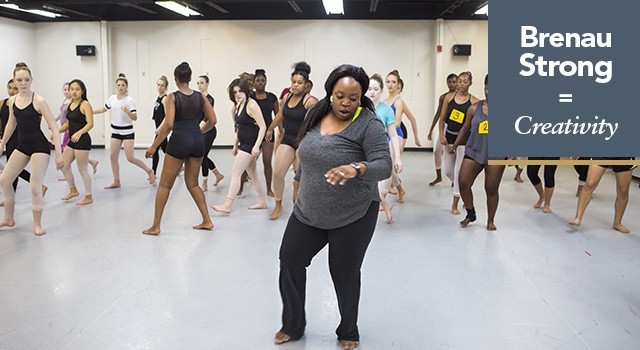The Discombobulation of Madia Cooper-Ashirifi
By James Swift
Madia Cooper-Ashirifi, WC ’04, confesses that she found it a bit discombobulating to return to Brenau as a professor scarcely more than a decade after she departed as a student. It’s a good word for a dancer to know discombobulate: something that upsets your balance, throws you off your game, breaks your concentration – in short, the kinds of distractions she tries to teach young dancers to combat.
She found a lot of changes at her alma mater. Of the three mentors she had on her path to a B.F.A. in dance, only one – Jolie Long – remains on faculty. Cooper-Ashirifi wondered whether she can instill in today’s students the same passion her professors gave her.
Apparently she rose to the task. Cooper-Ashirifi worked with dance composition students last fall, providing them guidance as they pieced together their own choreography for the annual Evening of Dance concert in November entitled I Am…. Although she originally intended to stick around just long enough to present her own choreography (a production titled Kumpo, which was inspired by Senegalese mythology) at the 2016 spring faculty concert, before the end of her first term on the faculty her contract was extended another year. As a professor, Long says Cooper-Ashirifi is demanding but caring. Although she makes her students work hard to hone their craft, she also takes the time to meet with them one-on-one to discuss ways to improve their performances.
When Cooper-Ashirifti was a student, one of her top professors and mentors was Carol Smiarowski, who died in 2007. Vincas Greene, who was also on the faculty when Cooper-Ashirifi was a student and succeeded Smiarowski as head of the Brenau dance program, returned to his home in Washington state at the end of the 2014-15 academic year. Having on the faculty someone like Cooper-Ashirifi who had been influenced by both of them is a boon to the program continuity, Long says. “She brings a good sense of tradition, and she understands the university because she went through it as a student,” Long says. “She is very much her own woman, her own self and her own artist. She truly personifies the ‘gold refined by fire’ process.”
Drive and Passion Survives
Born in Ohio and raised in Albany, Georgia, Cooper-Ashirifi has considerable experience in African dance forms, particularly in the synthesis of American and West African influences. The daughter of Liberian-Americans, she descended from one of the early residents of Liberia, the the West African nation that got its beginnings in the early 19th century primarily as a haven and homeland for African slaves freed from bondage in the Caribbean, the United States and other parts of the Americas. She earned an M.F.A. from the College at Brockport in New York, and then taught in high school and at Middle Tennessee State University.
There have been other changes since she left Brenau as a student. The only way Cooper-Ashirifi and her peers could study the nuances of dance was by witnessing performances on stage in “real-time,” which has no rewind button. However, today’s YouTube generation can see any kind of dance any time they wish streaming live over the internet from somewhere. Although she says she feared that such an abundance of riches might over-saturate the students and dampen their desire to study, she found the opposite to be the case.
“Their drive and their passion is still there,” Cooper-Ashirifi says, “and as long as that it is there, I can do my job.”
In 2010 she also joined a performance troupe specializing in Ghanaian dance and during the years since she has participated in more than 50 performances across the Southeast with the Mawre & Company troupe – a resume that includes four concerts at the annual Bonnaroo Music and Arts Festival in Manchester, Tennessee.
Cooper-Ashirifi says the medium of dance is incredibly multifaceted. Beyond its value as stage entertainment, the art form also has deep significance in religious practices, socialization and countless life passage celebrations. It can also reflect one’s culture, as well as how one identifies with his or her own background.
“If we look through a historical lens, we know that dance has accompanied many of the most important social and political events, through every culture,” she says. “What the voice can’t provide, the body can.”
That is precisely the premise of I Am Cooper, which literally represents her life work. The long-term project, which is still in the development phase, explores Cooper-Ashirifi’s Liberian roots, extending to her great, great grandfather, who became one of the nation’s original settlers in the mid-1800s. For her, there is no medium better than performance arts that is suited to the dual purpose of helping her simultaneously pay homage to her ancestors and capture her sense of self.
““All cultures use dance as an expression and a form of communication,” she says, “and I love blending the African diaspora with Western dance forms.”Dance is the true reflection of one’s cultural identity,” she says. “The body itself is a living archive.”

